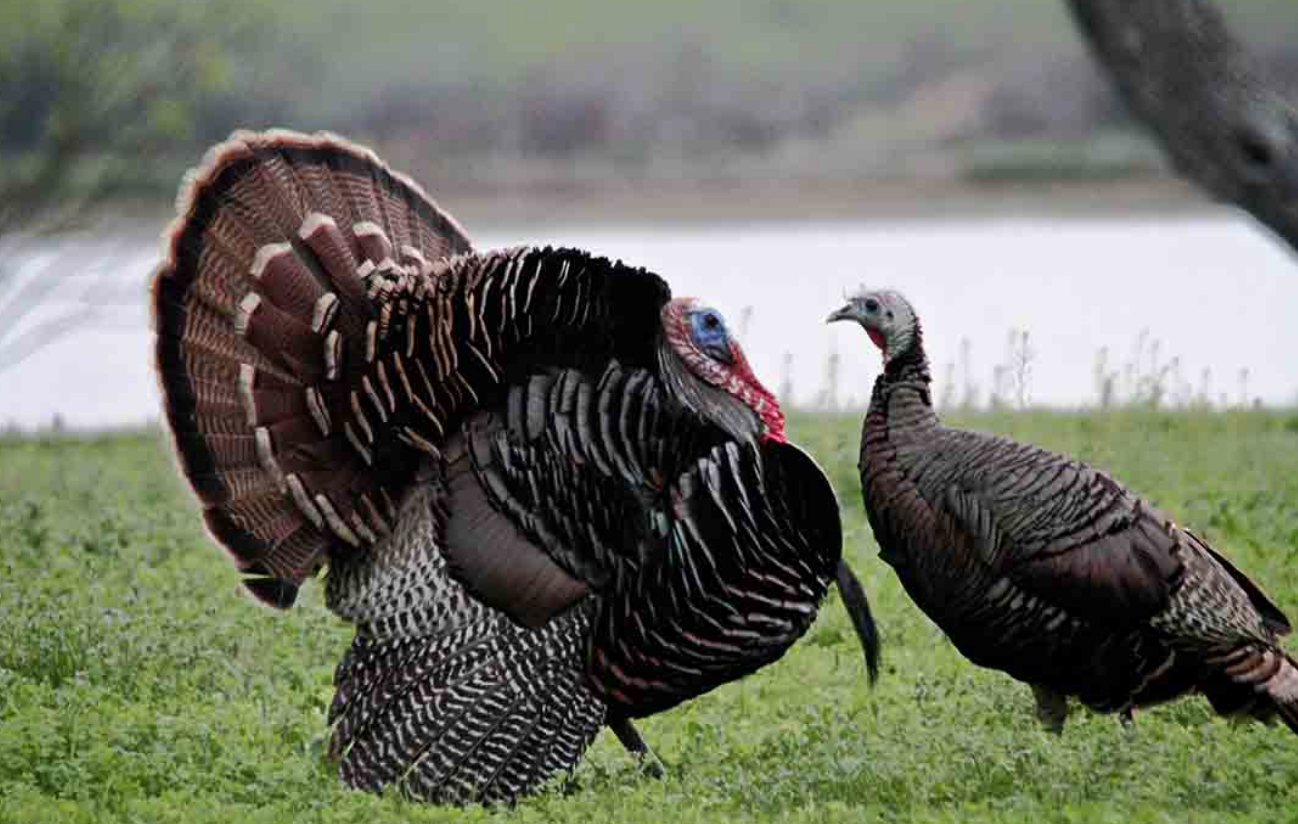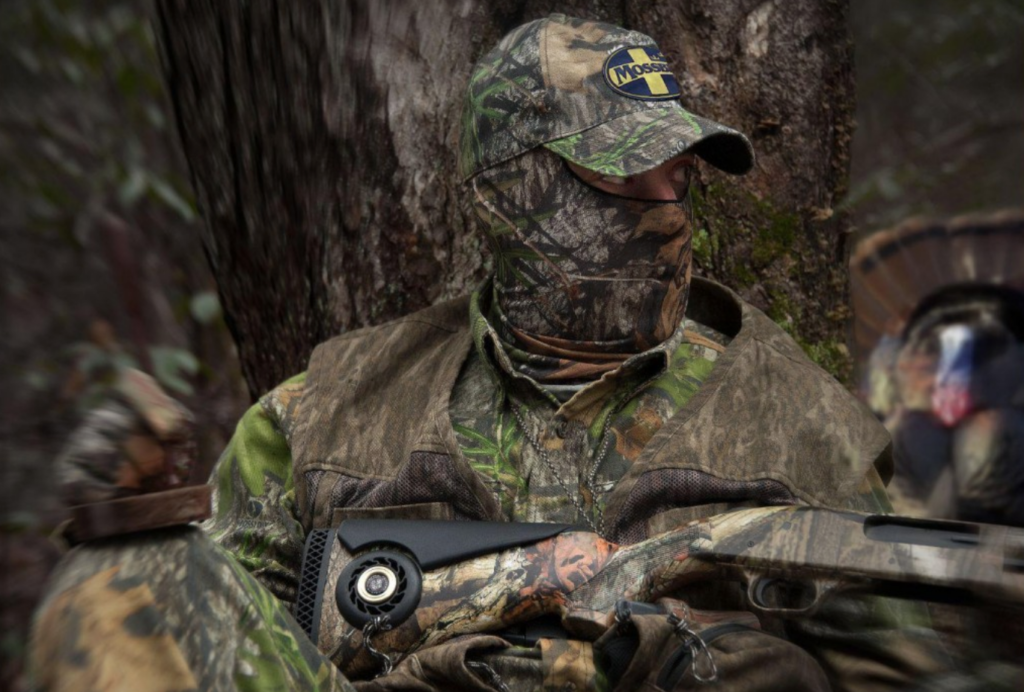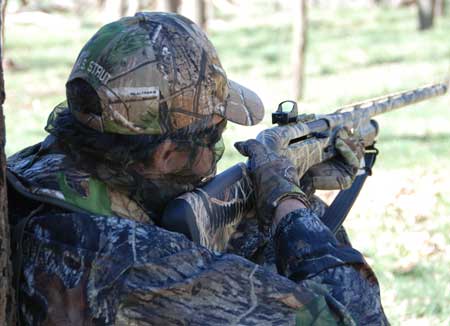There’s a correct time and place to make a bold play on a longbeard, so make sure the odds are in your favor before going for it.
By Joel Nelson
You’ve heard aggressive calling before. On TV, sitting next to your buddy, or sometimes even in the woods just after fly-down as two hens dish out a bevy of insults to one another. The results of which can be wholly ineffective, or strangely successful, at times with no rhyme or reason separating the two responses. Similarly, you’ve no doubt been a part of some “that’ll never work” style moves in the turkey woods that ended up paying dividends. Maybe a 20-yard reposition on some birds working around you, or a complete end-around where you reconnect with a ranging flock you last laid eyes on hours prior.
Zero-to-hero moves are what make turkey hunters get out of bed in the morning, but often there’s a purpose to the practice, rather than haphazard hunters just getting lucky while walking about the woods. Of course, that’s the best way to learn some aggressive tactics, as luck can turn into advantage and then eventual confidence when you learn to apply aggression at the right moment. It can also be an Achilles heel when practiced without moderation, and only in impatience do you break out the heavy calling and big moves. The trick is learning when aggressive is the order of the day, rather than the one thing that’ll push them away.
Calling All Toms
You’ve heard the adage, “take their temperature,” when it comes to calling? As it turns out, these birds really are individuals, making it difficult to lay down predictions based on what you may run into each morning this spring. The best a hunter can hope for is a well-calibrated, internal odds calculator, similar to the one you see at the bottom of a televised poker match. Given any hand you’re dealt, you can often do only so much, but it’s always within your power to make a certain play when faced with specific conditions in hand. So it goes with aggressive calling.

World Champion caller Billy Yargus has used aggressive calling tactics for decades with great success. Photo credit Joel Nelson
If you’re bad at cutting, kee-kees and cluck-purr combinations, or even less than confident, it may not be something you try this spring. A morning in the woods with World Champion caller Billy Yargus some years ago drove home the point that all calling is not created equal, and his incessant yelping was far greater than my own for one primary reason — it sounded better. Call it rule one of getting a bit spunky with your turkey speak, as you better sound like a live hen when you let it all hang out. There’s just something about upping the call volume and getting more staccato that takes a mouth call, or any other call, to the edge of its capabilities.
That’s why it’s often best to show that hand only when you need to — not just in desperation as a bird moves away, but sparingly in key situations. The first way that has paid dividends for me is getting aggressive as a natural crescendo to the conversation I’ve already been having with a gobbler. The trick, as so many other hunters already know, is the being-quiet part, where you resist all urges to call after the last salvo for at least 10 to 15 minutes. If the bird or birds are particularly hot, it’s fine to wait twice that long, or more. Last year in Wisconsin I killed one of a pair of toms that came nearly 500 yards, not making a peep the whole way as they marched for 30 minutes in my direction. I was lucky to see them coming from a sparse hillside, but it made me think of how many birds in the past have tried to close some distance quietly that I moved on from and never saw.
Another aggressive play is directly off the roost. If I have a bird turned on the limb in my direction, and he’s gobbling at me more than other nearby hens, I’ll try to cutt at him and offer some excited yelps as he’s flying down. I’ve heard enough live hens offer their excitement when gobblers head out of the trees to know this is a natural response to breeding birds in many parts of the country. I want him to hit the ground and hear me being fired-up about it. That bird will usually close the gap quickly if you shut up and he’s hot enough.
Every turkey hunter needs a deep bag of tricks, and especially for flocked-up or interested-but-noncommittal longbeards, I like to offer some fighting purrs as a last-ditch effort. Most often, this is effective for me when birds are within or around 100 yards from my setup, and hung up. Start with a friction call and mimic a hen that’s starting up, then respond with a mouth call. Mimic each other back and forth, and use the call you’re better with to step on the other hen. Interrupt her and eventually break into the fighting purrs, complete with simulated wing flaps from your baseball cap. It’s a true zero-or-hero move, usually garnering a response of some kind, although not always a good one. But sometimes, with nothing left to lose, you have to give it a shot.
Beating Feet
It’s important to note that covering ground as a hunter can help you as much as hurt you, although the same is often true in reverse. Too often, without ample ground and multiple flocks of birds to hunt, hunters get aggressive and ruin good locations simply by moving around too much. The old principles of moving in cover only rather than out in the wide open, staying in the shadows, and generally slinking through cover rather than casually walking around, apply even more when you only have a 40-acre chunk to hunt. Yet, if you’re lucky enough to have several areas to hunt and multiple looks at unpressured birds, you can afford to be a bit more risky with your movements. Contacting more birds in this scenario simply offers more chances to kill one.
In the case of field birds, so often we set up in a location where we have a commanding view of a legion of longbeards and their hens, yet this view can keep us glued to a tree where we’ll never fire a shot. I much prefer utilizing the thickest screening cover up against an opening, sneaking closer and glassing to find moving turkeys. With scouting from game cameras or even a windshield, you can often decipher the general timing and direction of travel, even getting down to determining the spot in a fence they most often cross. In this situation, with moving birds, I’m not too proud to get in front of where they want to be, then call to steer them in for the final steps. Some call it bushwhacking or unsportsmanlike — I call it woodsmanship and effective hunting strategy that’s tougher than it looks, especially on big ground with multiple hens.
Less controversially, hunters have been making aggressive moves in tandem for many years, and it remains effective because of the tendency of some birds to hang up. Here, again, is where realism in your calling and movements can pay off handsomely. One of my turkey hunting mentors was a guide in the Black Hills of South Dakota for decades, and he learned that scratching was one of his best calls on a still day. We killed an Oklahoma tom together a few years back where he crawled around behind me some 80 yards, yelping softly, scratching loudly, and generally sounding like a flock of birds moving through the oak stands we hunted. That tom was simply making his way to what we both thought sounded just like a group of birds picking acorns in the timber.
The Walk-Off
Hunt enough, and you start to see some patterns develop, especially in the case of anxious gobblers. Chances are that you’ve had a tom that wouldn’t commit to your location, but gobbled immensely, eventually settled in a spot, gobbled his brains out, then walked off while gobbling over his shoulder. I’m guessing you know the type. He goes to where he thinks you two should meet up, announces his undying love, and hits the road barking the whole way. I’ve killed dozens of these birds in the past decade by employing a pretty specific trick when they first start to “walk-off.”
If you know the area you hunt well, you’re at a distinct advantage, as the exact area these birds gobble-out becomes a kill zone of epic proportions. Your move is to let him move away, no more than 100 to 200 yards as you get to that location, plop down quickly, and hit him with aggressive calling right away. You’re simulating a hen that’s done her part. One that’s heard the gobbler, gone to where he drew a line in the sand, and is impatiently chewing him out for leaving without her. For whatever reason, I’ve had numerous gobblers from across the country, in a variety of terrain, with and without hens, march directly back to that location, head bobbing and neck outstretched the whole way.
There’s something to be said for the fact that he just traversed those steps, and likely considers the path somewhat safe given he was there mere seconds ago. Or maybe it has to do with the fact that toms gather their hens in spots like these all over, and you’re simply at the right meeting location at the right time. Like so many aggressive tactics, it requires directly noticing the type of bird you’re dealing with, and immediate action to get where you need to be before the bird moves too far away. Yet, when it continues to work again and again, it smacks of that poker-like odds-maker discussed earlier. Given that bird and the hand I’m dealt with in the woods, I know if I execute the “walk-off” well, I’m bringing aces to the table.
While it’s rare to consistently hit birds with aggressive talk and movement and be successful, there are times when it’s not just recommended, but crucial to being successful on a given day. All-star 2-year-olds make an incredible show for those that love to hammer loud and long on their calls, but that kind of activity can cost you in a number of situations. Better yet to pick your spots and get feisty only when the situation calls for it.






